Travel photographer reveals that this is one of the most inaccessible inhabited areas in the world during winter, yet those who bravely embark on the journey are rewarded with breathtaking scenery.
Zanskar is an extremely remote valley located at an altitude of about 3,500 meters, with peaks soaring over 7,000 meters, in Ladakh, a territory in northern India. For many years, during the winter, the main route to Zanskar has been the 64 km long Chadar route, which takes walkers across the frozen Zanskar River. This is an extremely dangerous path, where travelers risk avalanches, blizzards, or falling through broken ice into the river below.
Traveling by land is generally not the best option due to heavy snowfall and the risk of avalanches, although many measures have been implemented to ensure safety.
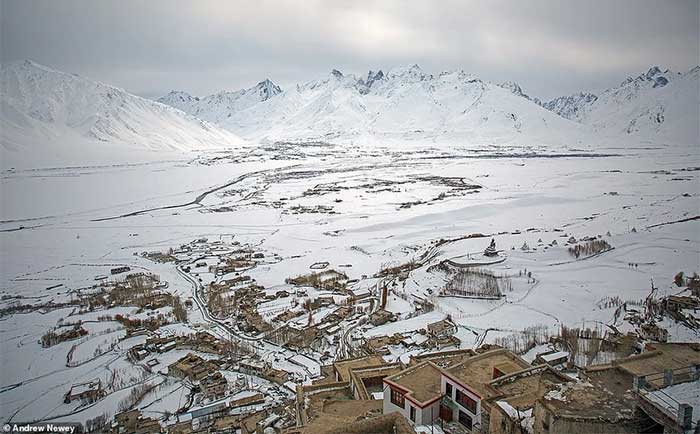
Travel photographer Andrew Newey has visited Zanskar, an extremely remote valley in northern India. This is a stunning view of the Zanskar valley from Karsha Monastery.
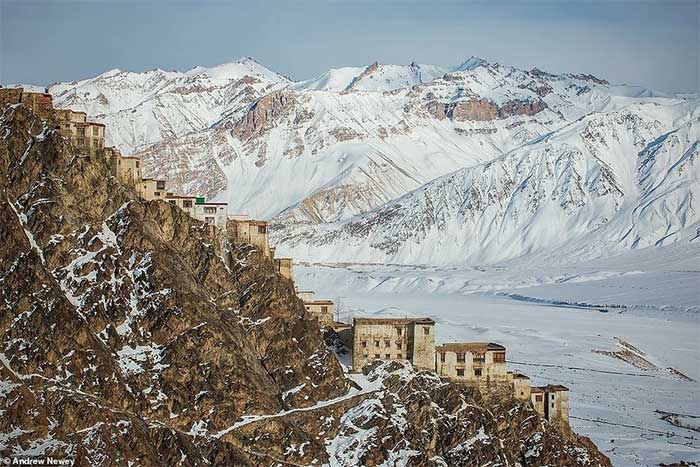
This enchanting photo by photographer Andrew Newey shows Karsha Monastery “bathed” in beautiful golden light at sunset on a winter day.
Another way to traverse this arduous journey is by helicopter. This service was newly implemented in 2022, transporting tourists from the city of Ladakh to Zanskar Valley in just 45 minutes.
Photographer Andrew Newey, 44, made his journey to Zanskar in the winter of 2022, pointing his camera lens at the landscapes and residents of the 7,000 km2 area that is almost completely isolated from the outside world. This place is home to several dozen villages. The results that Andrew brought back are astonishing.

Buddhism plays a very important role in daily life in Zanskar Valley. Locals combine prayer with their daily work. For example, in this photo, we can see an elder walking clockwise around a stupa, a Buddhist monument, after collecting firewood.
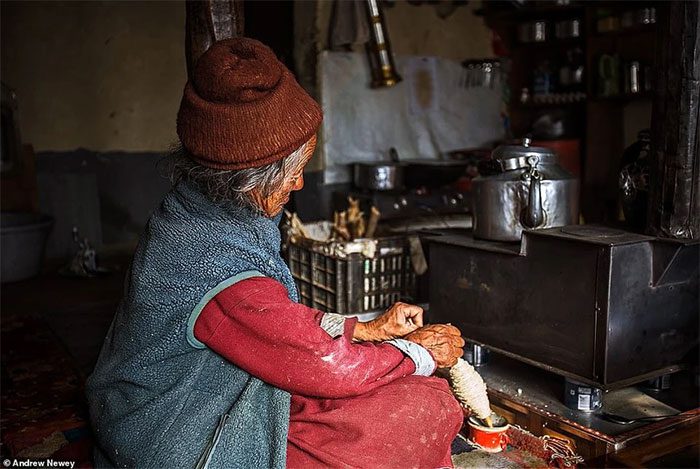
An elderly man spinning wool by the fire at home in Purne, a small village in the remote Zanskar region.
Andrew explains: “Accessing Zanskar Valley in winter is incredibly challenging. Until recently, this area remained almost completely isolated throughout the winter. One of the main challenges is waiting for the opportunity to fly, as helicopters can only fly in the morning when there are no clouds in the sky and visibility is good. The scenery from the helicopter window is truly quite magnificent.”
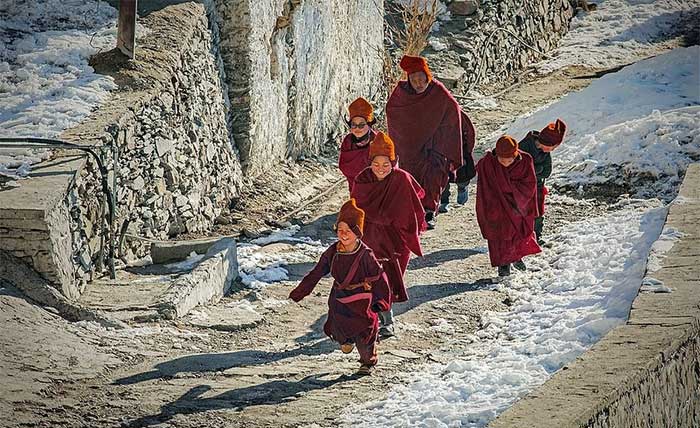
The Zanskari people are extremely resilient. Living in such a harsh environment, they must be able to adapt to weather changes.
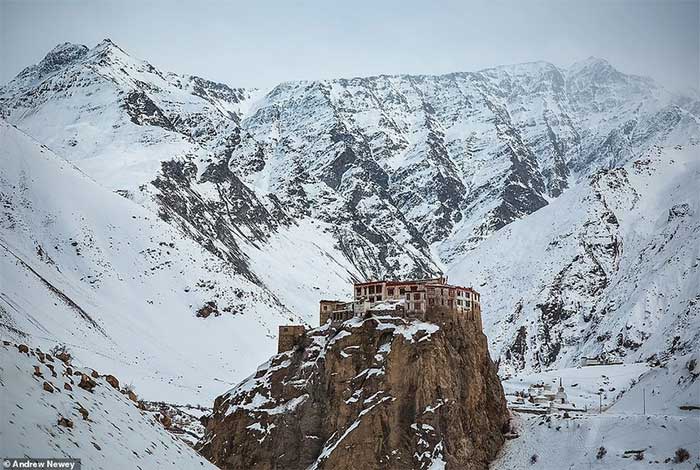
A beautiful photo showing Bardan Monastery perched on a cliff.
Andrew finds “the majestic mountains of the Zanskar range”. It is these mountainous landscapes that inspired Andrew’s visit. He feels they will create “incredibly striking” photographs.
Andrew, who lives in Dorset (England) but travels the world as a photographer, is also drawn to the challenge of accessing this remote land. “Speaking from a photography perspective, I love the challenge,” he admits.
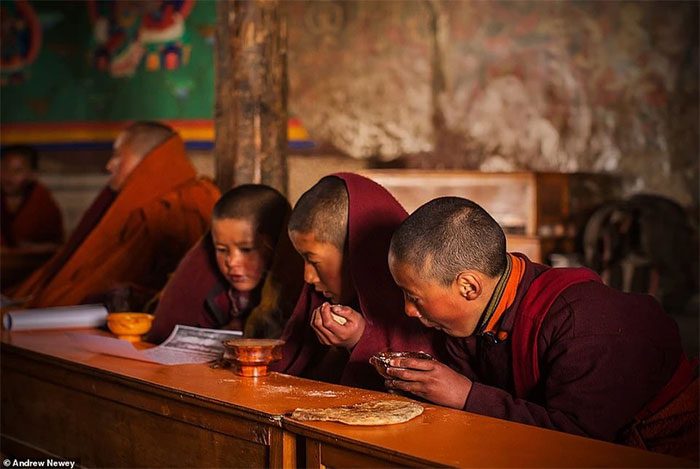
Morning prayers at Karsha Monastery, a Buddhist monastery in Padum in the Zanskar region.
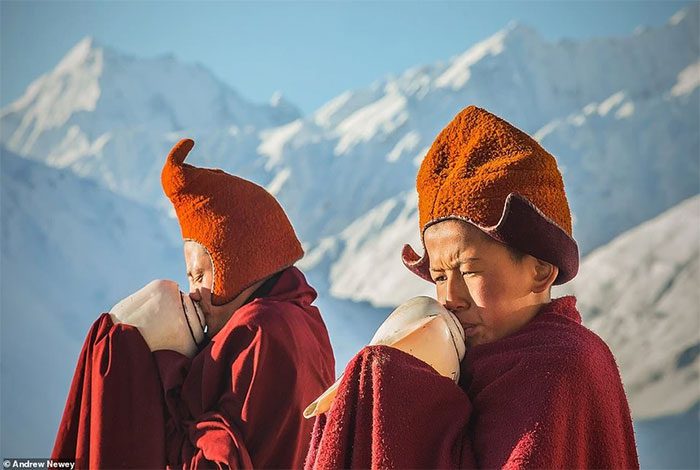
Every early morning, two young monks blow conch shells and call for prayers.
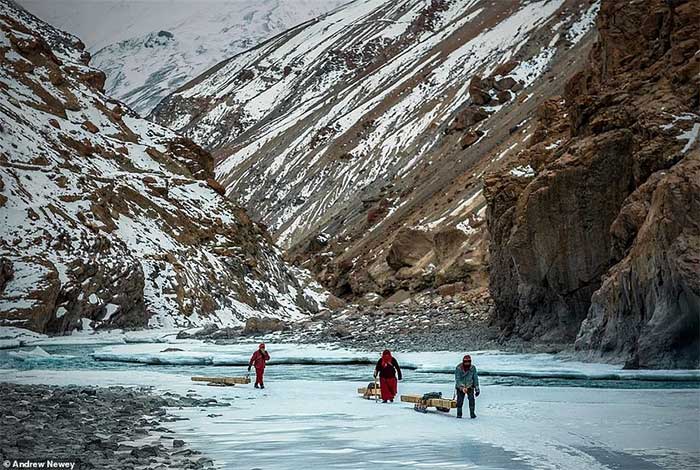
In winter, when the rivers freeze, monks can transport essential supplies to the remote Phugtal Monastery using wooden sleds.
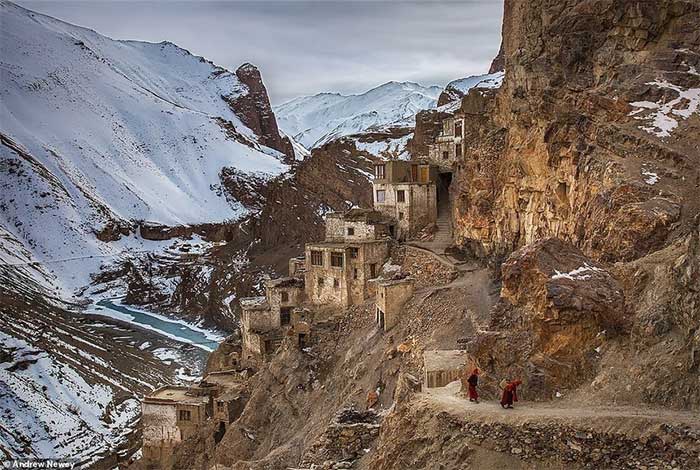
Two monks carrying water back to their residence in Zanskar.
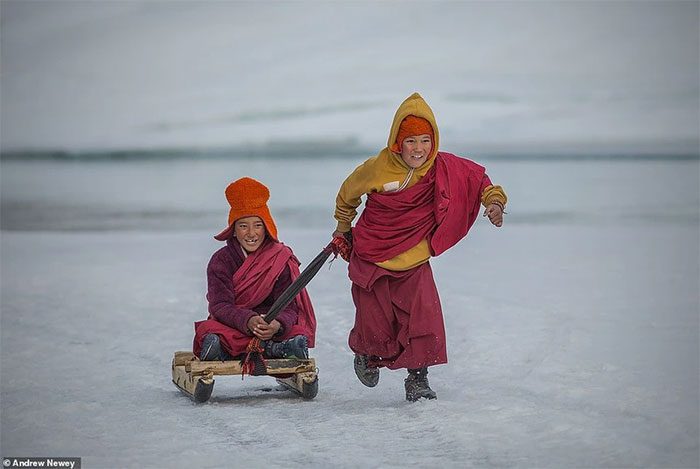
Two monks enjoying a moment of relaxation by riding a sled on the frozen riverbank in Zanskar.
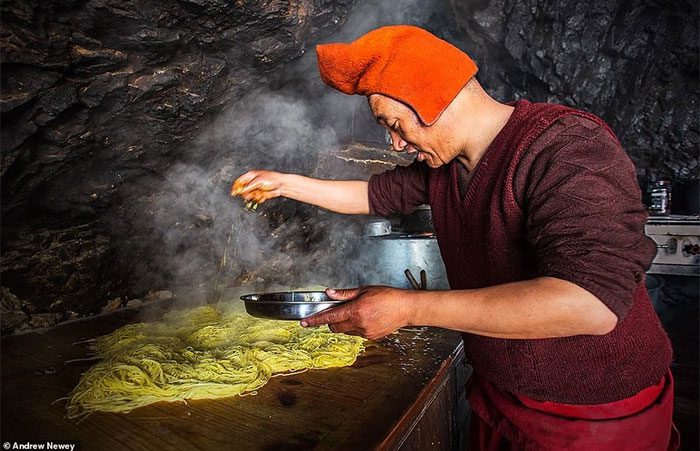
A monk at Phugtal Monastery preparing a noodle feast for the celebration.
“Life in Zanskar is very simple; however, I have become accustomed to living with locals in remote areas, so for me, this is nothing special. Like in all the remote places in the world I have visited, the people there seem completely content with what they have,” Andrew shared.
He received a warm welcome from the locals. Andrew said: “The Zanskari people are extremely friendly and very happy to be photographed. Some of the older folks were initially a bit shy about having their photos taken, but after I lived with them for a few days, they quickly began to accept my wishes.”
However, the harsh weather conditions are a crucial consideration. The experienced photographer stated: “The conditions there in winter are truly harsh, especially with strong winds. Very few tourists go there in winter, so all hotels and guesthouses are closed, transportation becomes very scarce, and people can only stay hidden until spring.”
During Andrew’s visit, the average daytime temperature was around -10 degrees Celsius, dropping sharply to about -20 to -25 degrees Celsius at night.
He said: “The locals are accustomed to the cold and only use blankets to keep warm on freezing nights. Most people have a small wood stove for cooking and heating their homes. The Zanskari people are extremely resilient. Living in such a harsh environment, they must be able to adapt to the changing weather.”
Andrew noted: “Climate change is having a profound impact on the area – rising temperatures are causing rapid glacial melting. This leads to flooding and drought. Villagers are struggling with farming and livestock.”
Climate change also affects the access routes to Zanskar. Andrew remarked: “Glaciers are not forming at the right times, making the ‘ice roads’ more dangerous for walking and transporting essential supplies. Snowfall is increasing and becoming more erratic, which means livestock and other animals are having difficulty finding food.”
Buddhism plays a very significant role in daily life in Zanskar Valley. A highlight during Andrew’s time there was visiting the Phugtal Monastery, a spectacular Buddhist monastery built around a cave in southeastern Zanskar over 2,500 years ago.
To reach the monastery, located at an altitude of 4,267 meters, he had to walk along the frozen Lungnak River, which was “completely flat and extremely slippery.”
Andrew stated that the monastery is home to about 30 to 40 monks during winter, while in warmer months, there are about 80 monks. The younger monks often “go back home to their families” during winter break.
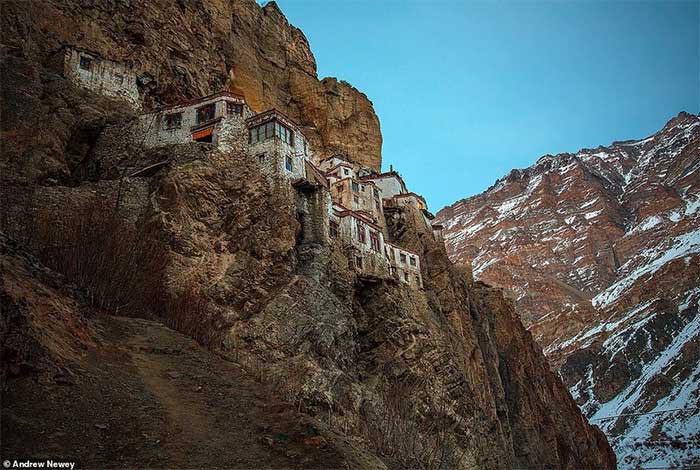
Phugtal Monastery at sunset. Andrew Newey said that the monastery looks “like a giant beehive clinging to the sheer cliff face” when viewed from afar.
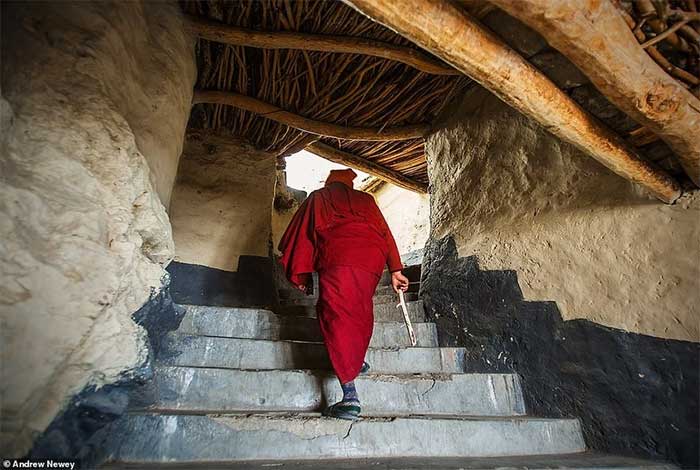
A monk climbs several steps to the rooftop to pray early in the morning at Phugtal Monastery.
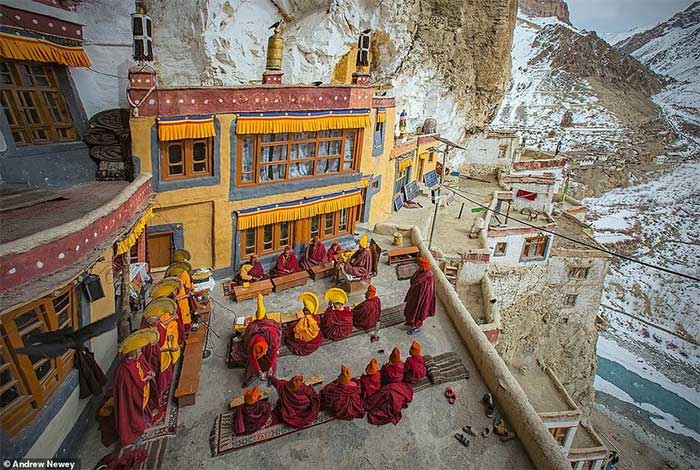
Monks brave the cold as their morning prayer takes place on the rooftop of Phugtal Monastery in -20 degrees Celsius.
Among the many landscapes Andrew encountered in Zanskar, he stated that his favorite view was of Phugtal Monastery as seen from the path leading to it. The photographer remarked that from a distance, the monastery looks “like a giant beehive clinging to a sheer cliff.”
“In the late afternoon light as the snowstorm approaches, this scene is truly quite magical.”
“It is the remoteness, the breathtaking beauty of the snow-covered mountains, and the generosity and hospitality of the people that make Zanskar special and mystical,” Andrew commented after his journey.
Now, as this remote part of the world becomes more accessible, what impact will the growth in tourism have on Zanskar?
Andrew said: “Like many places around the world, tourism is truly a double-edged sword. On the positive side, tourists provide a much-needed boost to the local community’s income, but on the other hand, the increasing pollution from traffic and waste detracts from the inherent beauty and tranquility.”


















































